Purchase System Audit: Control Evaluation, Risks, and Testing Methods
VerifiedAdded on 2023/06/11
|6
|1283
|118
Report
AI Summary
This report provides an analysis of a purchase and payment system, identifying its strengths and weaknesses. Strengths include established policies, stock level order practices, segregation of duties, and involvement of managing directors for significant payments. Weaknesses identified are lack of proper documentation for orders, absence of quantity checks by warehouse assistants, and computer-aided cheque signing. The report also suggests tests to evaluate the effectiveness of existing controls related to policies, stock levels, segregation of duties, and managerial involvement. Finally, it discusses the likely impact of the identified weaknesses on audit risk, such as potential issues with audit trails, inventory valuation inaccuracies, and cheque approval processes. Desklib provides access to similar solved assignments and study resources for students.
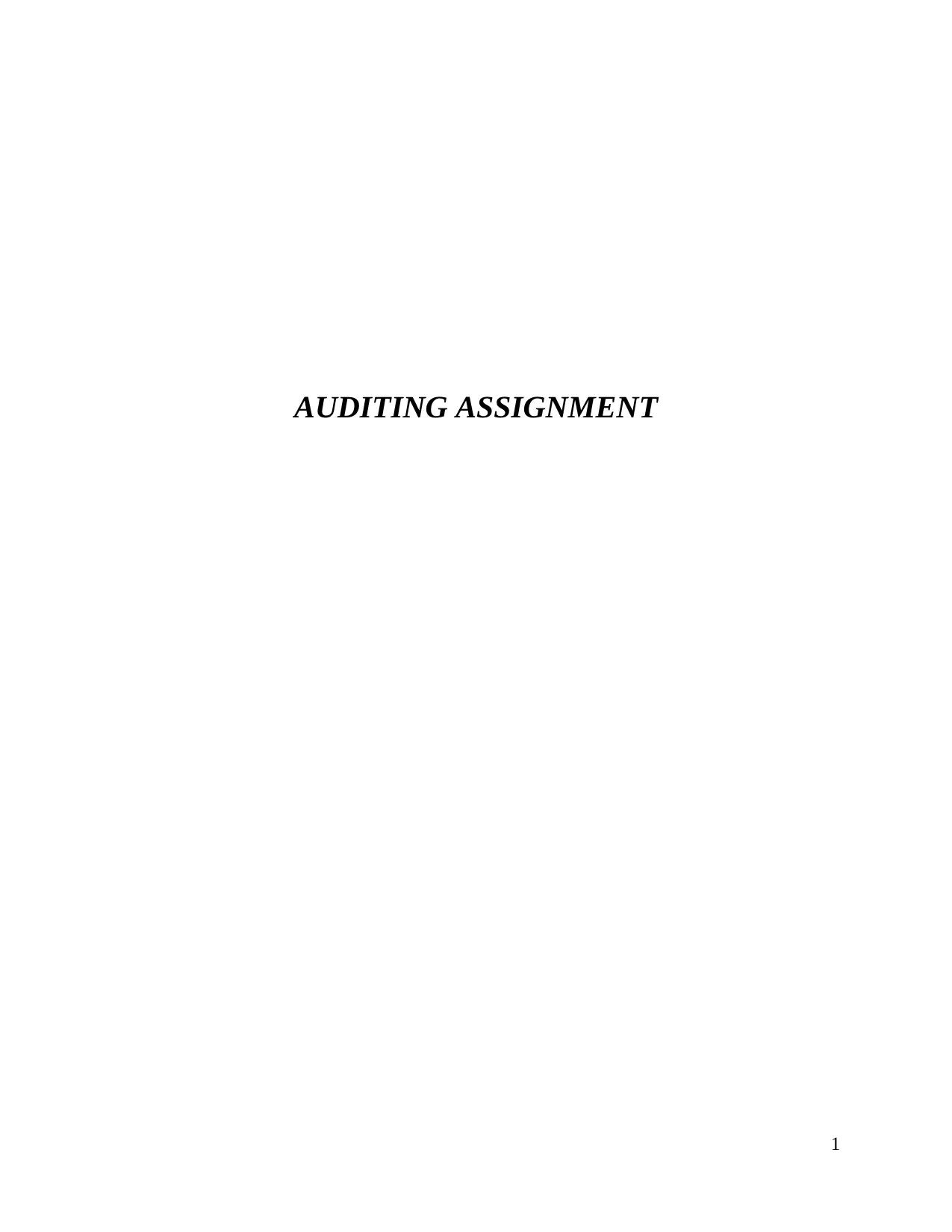
AUDITING ASSIGNMENT
1
1
Paraphrase This Document
Need a fresh take? Get an instant paraphrase of this document with our AI Paraphraser
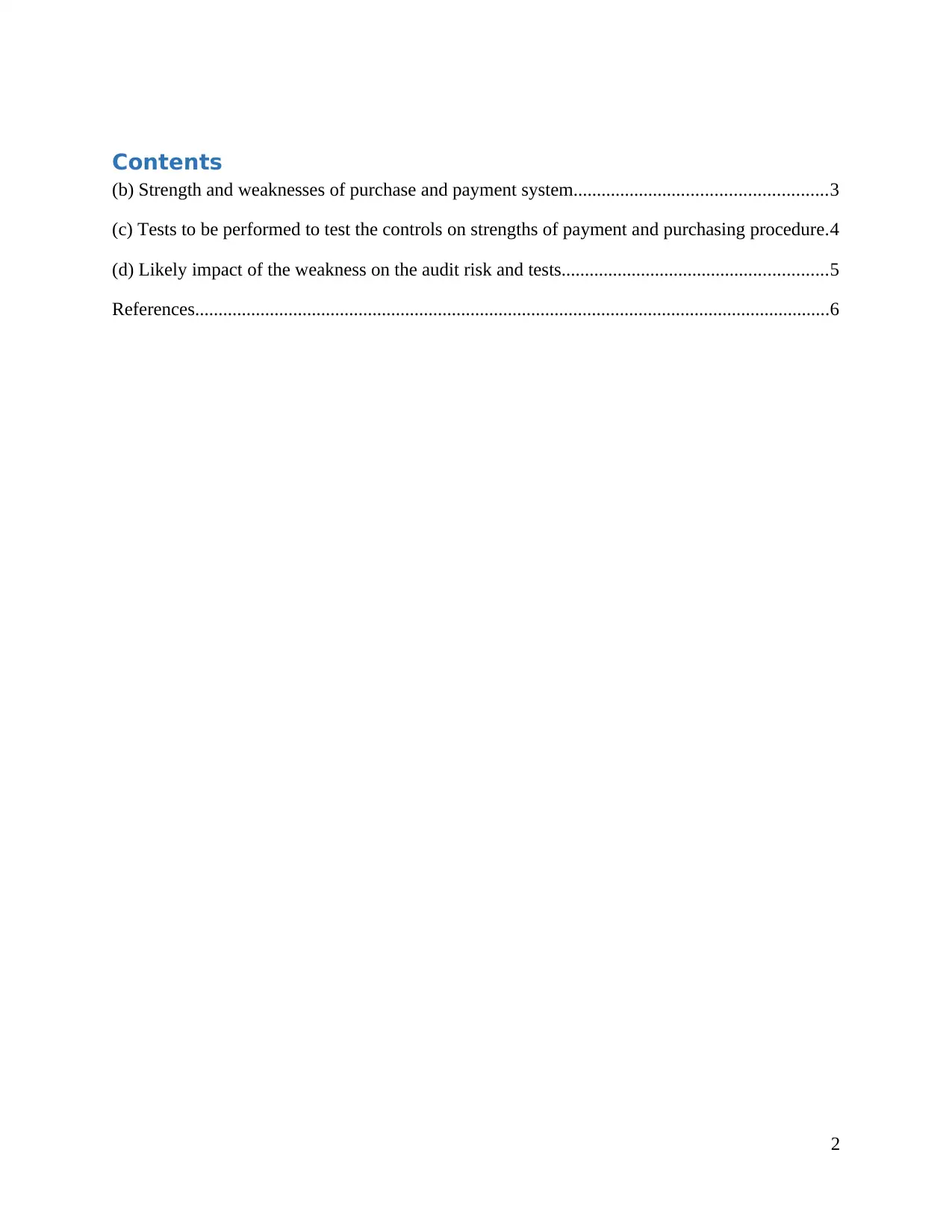
Contents
(b) Strength and weaknesses of purchase and payment system......................................................3
(c) Tests to be performed to test the controls on strengths of payment and purchasing procedure.4
(d) Likely impact of the weakness on the audit risk and tests.........................................................5
References........................................................................................................................................6
2
(b) Strength and weaknesses of purchase and payment system......................................................3
(c) Tests to be performed to test the controls on strengths of payment and purchasing procedure.4
(d) Likely impact of the weakness on the audit risk and tests.........................................................5
References........................................................................................................................................6
2
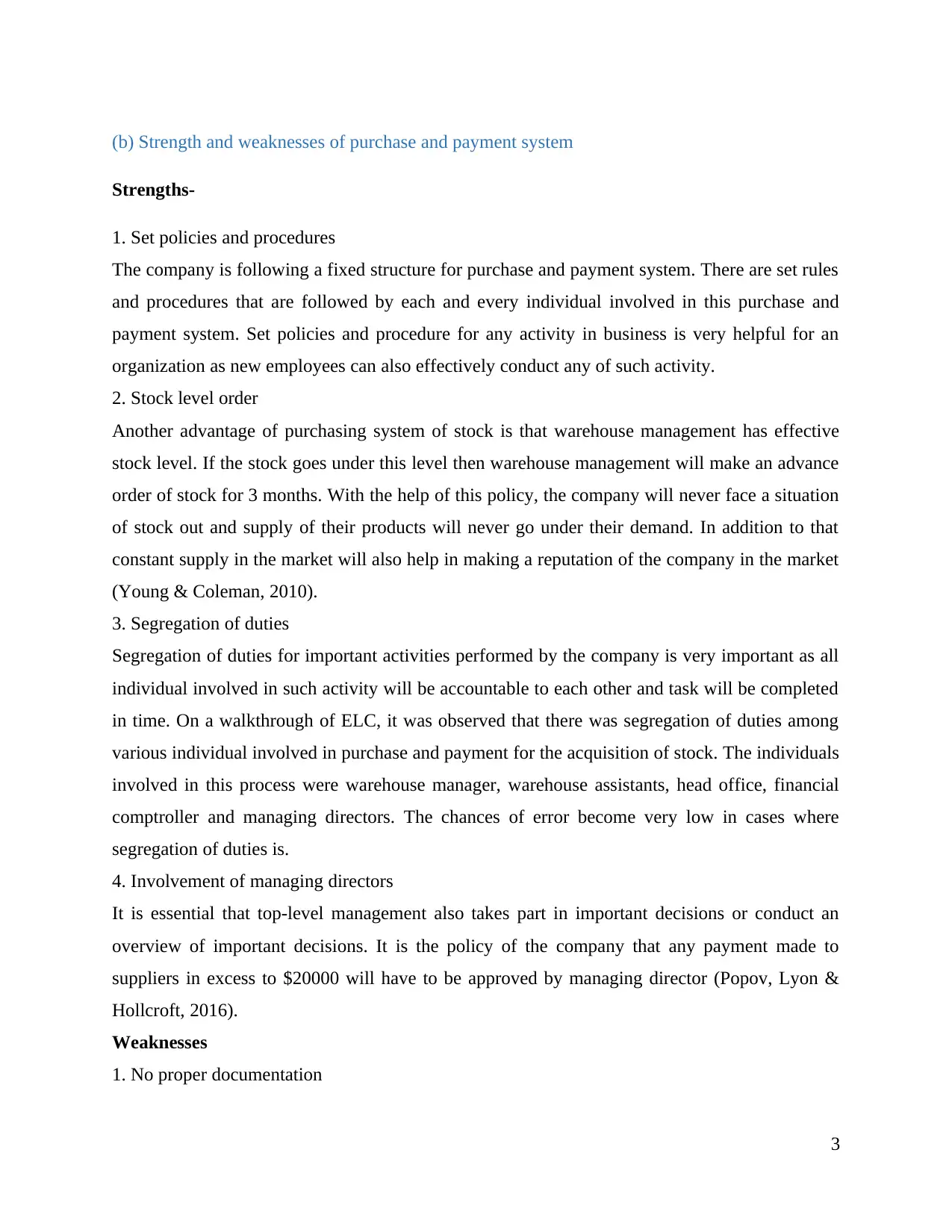
(b) Strength and weaknesses of purchase and payment system
Strengths-
1. Set policies and procedures
The company is following a fixed structure for purchase and payment system. There are set rules
and procedures that are followed by each and every individual involved in this purchase and
payment system. Set policies and procedure for any activity in business is very helpful for an
organization as new employees can also effectively conduct any of such activity.
2. Stock level order
Another advantage of purchasing system of stock is that warehouse management has effective
stock level. If the stock goes under this level then warehouse management will make an advance
order of stock for 3 months. With the help of this policy, the company will never face a situation
of stock out and supply of their products will never go under their demand. In addition to that
constant supply in the market will also help in making a reputation of the company in the market
(Young & Coleman, 2010).
3. Segregation of duties
Segregation of duties for important activities performed by the company is very important as all
individual involved in such activity will be accountable to each other and task will be completed
in time. On a walkthrough of ELC, it was observed that there was segregation of duties among
various individual involved in purchase and payment for the acquisition of stock. The individuals
involved in this process were warehouse manager, warehouse assistants, head office, financial
comptroller and managing directors. The chances of error become very low in cases where
segregation of duties is.
4. Involvement of managing directors
It is essential that top-level management also takes part in important decisions or conduct an
overview of important decisions. It is the policy of the company that any payment made to
suppliers in excess to $20000 will have to be approved by managing director (Popov, Lyon &
Hollcroft, 2016).
Weaknesses
1. No proper documentation
3
Strengths-
1. Set policies and procedures
The company is following a fixed structure for purchase and payment system. There are set rules
and procedures that are followed by each and every individual involved in this purchase and
payment system. Set policies and procedure for any activity in business is very helpful for an
organization as new employees can also effectively conduct any of such activity.
2. Stock level order
Another advantage of purchasing system of stock is that warehouse management has effective
stock level. If the stock goes under this level then warehouse management will make an advance
order of stock for 3 months. With the help of this policy, the company will never face a situation
of stock out and supply of their products will never go under their demand. In addition to that
constant supply in the market will also help in making a reputation of the company in the market
(Young & Coleman, 2010).
3. Segregation of duties
Segregation of duties for important activities performed by the company is very important as all
individual involved in such activity will be accountable to each other and task will be completed
in time. On a walkthrough of ELC, it was observed that there was segregation of duties among
various individual involved in purchase and payment for the acquisition of stock. The individuals
involved in this process were warehouse manager, warehouse assistants, head office, financial
comptroller and managing directors. The chances of error become very low in cases where
segregation of duties is.
4. Involvement of managing directors
It is essential that top-level management also takes part in important decisions or conduct an
overview of important decisions. It is the policy of the company that any payment made to
suppliers in excess to $20000 will have to be approved by managing director (Popov, Lyon &
Hollcroft, 2016).
Weaknesses
1. No proper documentation
3
⊘ This is a preview!⊘
Do you want full access?
Subscribe today to unlock all pages.

Trusted by 1+ million students worldwide
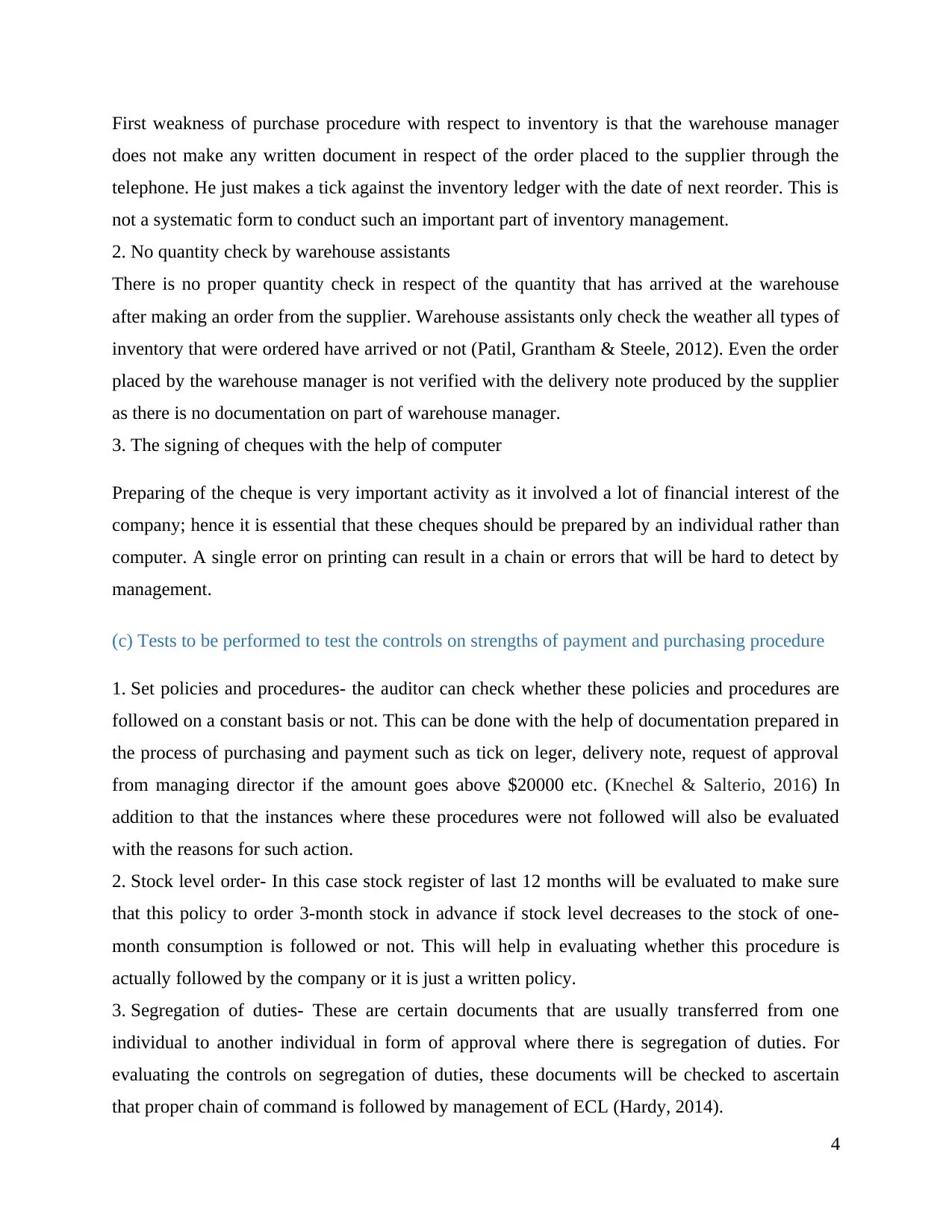
First weakness of purchase procedure with respect to inventory is that the warehouse manager
does not make any written document in respect of the order placed to the supplier through the
telephone. He just makes a tick against the inventory ledger with the date of next reorder. This is
not a systematic form to conduct such an important part of inventory management.
2. No quantity check by warehouse assistants
There is no proper quantity check in respect of the quantity that has arrived at the warehouse
after making an order from the supplier. Warehouse assistants only check the weather all types of
inventory that were ordered have arrived or not (Patil, Grantham & Steele, 2012). Even the order
placed by the warehouse manager is not verified with the delivery note produced by the supplier
as there is no documentation on part of warehouse manager.
3. The signing of cheques with the help of computer
Preparing of the cheque is very important activity as it involved a lot of financial interest of the
company; hence it is essential that these cheques should be prepared by an individual rather than
computer. A single error on printing can result in a chain or errors that will be hard to detect by
management.
(c) Tests to be performed to test the controls on strengths of payment and purchasing procedure
1. Set policies and procedures- the auditor can check whether these policies and procedures are
followed on a constant basis or not. This can be done with the help of documentation prepared in
the process of purchasing and payment such as tick on leger, delivery note, request of approval
from managing director if the amount goes above $20000 etc. (Knechel & Salterio, 2016) In
addition to that the instances where these procedures were not followed will also be evaluated
with the reasons for such action.
2. Stock level order- In this case stock register of last 12 months will be evaluated to make sure
that this policy to order 3-month stock in advance if stock level decreases to the stock of one-
month consumption is followed or not. This will help in evaluating whether this procedure is
actually followed by the company or it is just a written policy.
3. Segregation of duties- These are certain documents that are usually transferred from one
individual to another individual in form of approval where there is segregation of duties. For
evaluating the controls on segregation of duties, these documents will be checked to ascertain
that proper chain of command is followed by management of ECL (Hardy, 2014).
4
does not make any written document in respect of the order placed to the supplier through the
telephone. He just makes a tick against the inventory ledger with the date of next reorder. This is
not a systematic form to conduct such an important part of inventory management.
2. No quantity check by warehouse assistants
There is no proper quantity check in respect of the quantity that has arrived at the warehouse
after making an order from the supplier. Warehouse assistants only check the weather all types of
inventory that were ordered have arrived or not (Patil, Grantham & Steele, 2012). Even the order
placed by the warehouse manager is not verified with the delivery note produced by the supplier
as there is no documentation on part of warehouse manager.
3. The signing of cheques with the help of computer
Preparing of the cheque is very important activity as it involved a lot of financial interest of the
company; hence it is essential that these cheques should be prepared by an individual rather than
computer. A single error on printing can result in a chain or errors that will be hard to detect by
management.
(c) Tests to be performed to test the controls on strengths of payment and purchasing procedure
1. Set policies and procedures- the auditor can check whether these policies and procedures are
followed on a constant basis or not. This can be done with the help of documentation prepared in
the process of purchasing and payment such as tick on leger, delivery note, request of approval
from managing director if the amount goes above $20000 etc. (Knechel & Salterio, 2016) In
addition to that the instances where these procedures were not followed will also be evaluated
with the reasons for such action.
2. Stock level order- In this case stock register of last 12 months will be evaluated to make sure
that this policy to order 3-month stock in advance if stock level decreases to the stock of one-
month consumption is followed or not. This will help in evaluating whether this procedure is
actually followed by the company or it is just a written policy.
3. Segregation of duties- These are certain documents that are usually transferred from one
individual to another individual in form of approval where there is segregation of duties. For
evaluating the controls on segregation of duties, these documents will be checked to ascertain
that proper chain of command is followed by management of ECL (Hardy, 2014).
4
Paraphrase This Document
Need a fresh take? Get an instant paraphrase of this document with our AI Paraphraser
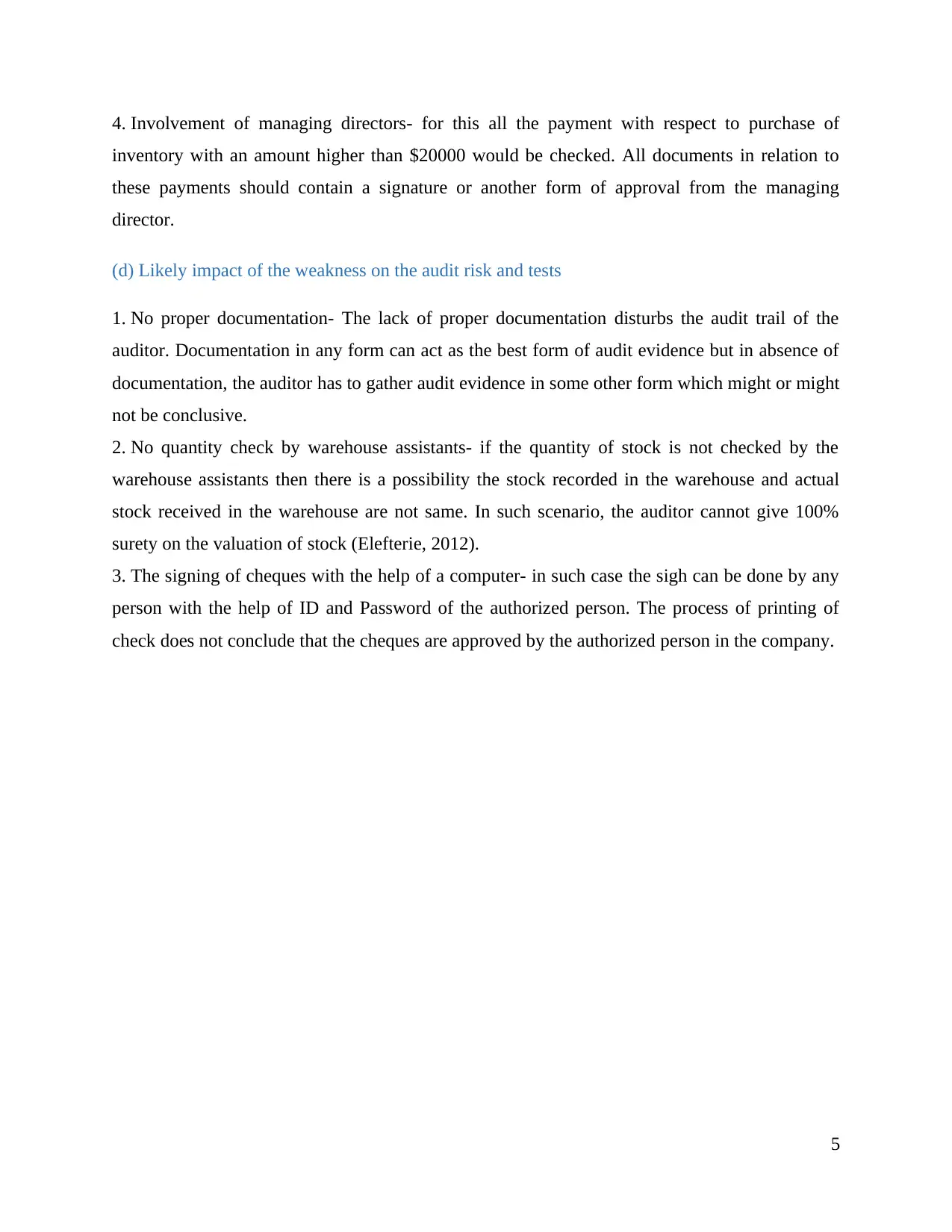
4. Involvement of managing directors- for this all the payment with respect to purchase of
inventory with an amount higher than $20000 would be checked. All documents in relation to
these payments should contain a signature or another form of approval from the managing
director.
(d) Likely impact of the weakness on the audit risk and tests
1. No proper documentation- The lack of proper documentation disturbs the audit trail of the
auditor. Documentation in any form can act as the best form of audit evidence but in absence of
documentation, the auditor has to gather audit evidence in some other form which might or might
not be conclusive.
2. No quantity check by warehouse assistants- if the quantity of stock is not checked by the
warehouse assistants then there is a possibility the stock recorded in the warehouse and actual
stock received in the warehouse are not same. In such scenario, the auditor cannot give 100%
surety on the valuation of stock (Elefterie, 2012).
3. The signing of cheques with the help of a computer- in such case the sigh can be done by any
person with the help of ID and Password of the authorized person. The process of printing of
check does not conclude that the cheques are approved by the authorized person in the company.
5
inventory with an amount higher than $20000 would be checked. All documents in relation to
these payments should contain a signature or another form of approval from the managing
director.
(d) Likely impact of the weakness on the audit risk and tests
1. No proper documentation- The lack of proper documentation disturbs the audit trail of the
auditor. Documentation in any form can act as the best form of audit evidence but in absence of
documentation, the auditor has to gather audit evidence in some other form which might or might
not be conclusive.
2. No quantity check by warehouse assistants- if the quantity of stock is not checked by the
warehouse assistants then there is a possibility the stock recorded in the warehouse and actual
stock received in the warehouse are not same. In such scenario, the auditor cannot give 100%
surety on the valuation of stock (Elefterie, 2012).
3. The signing of cheques with the help of a computer- in such case the sigh can be done by any
person with the help of ID and Password of the authorized person. The process of printing of
check does not conclude that the cheques are approved by the authorized person in the company.
5
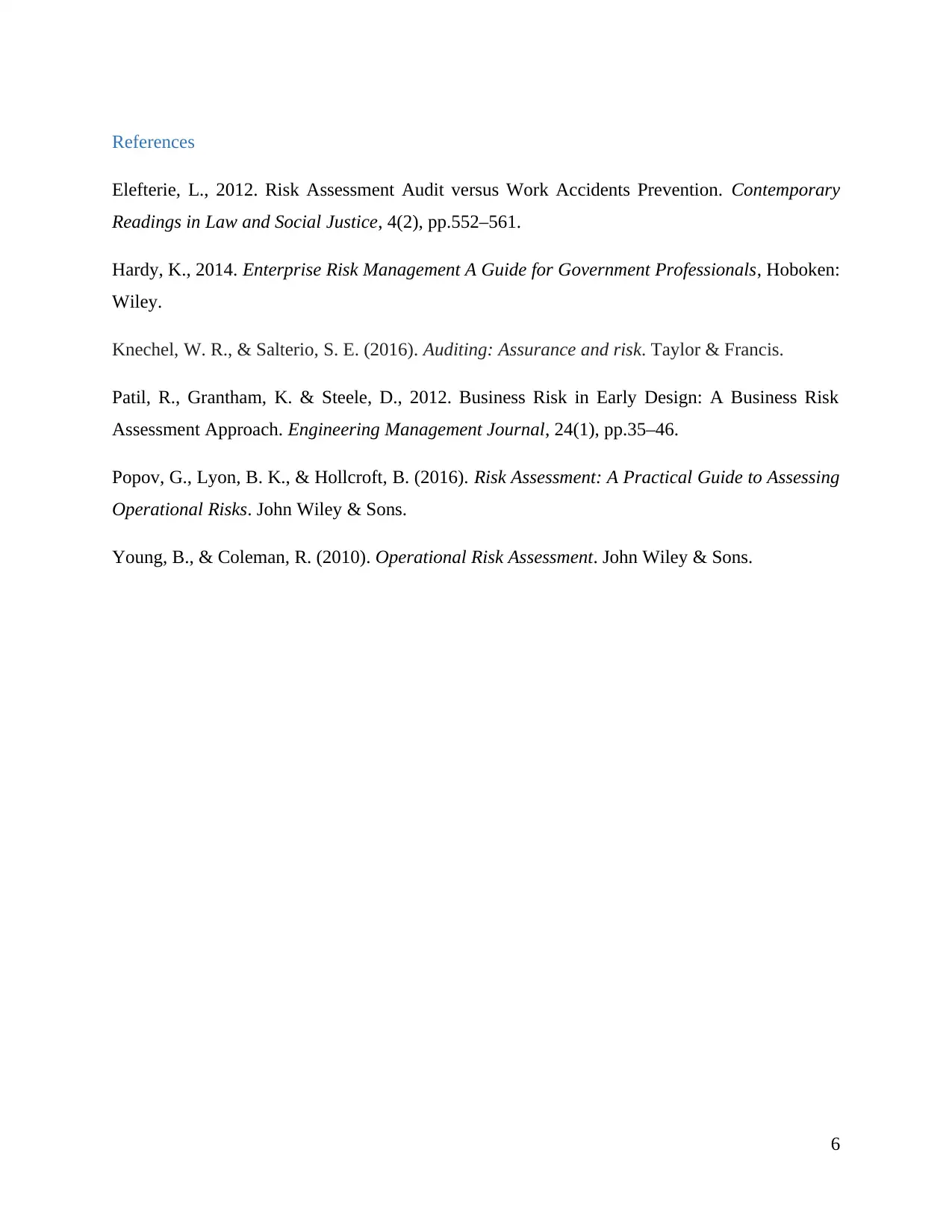
References
Elefterie, L., 2012. Risk Assessment Audit versus Work Accidents Prevention. Contemporary
Readings in Law and Social Justice, 4(2), pp.552–561.
Hardy, K., 2014. Enterprise Risk Management A Guide for Government Professionals, Hoboken:
Wiley.
Knechel, W. R., & Salterio, S. E. (2016). Auditing: Assurance and risk. Taylor & Francis.
Patil, R., Grantham, K. & Steele, D., 2012. Business Risk in Early Design: A Business Risk
Assessment Approach. Engineering Management Journal, 24(1), pp.35–46.
Popov, G., Lyon, B. K., & Hollcroft, B. (2016). Risk Assessment: A Practical Guide to Assessing
Operational Risks. John Wiley & Sons.
Young, B., & Coleman, R. (2010). Operational Risk Assessment. John Wiley & Sons.
6
Elefterie, L., 2012. Risk Assessment Audit versus Work Accidents Prevention. Contemporary
Readings in Law and Social Justice, 4(2), pp.552–561.
Hardy, K., 2014. Enterprise Risk Management A Guide for Government Professionals, Hoboken:
Wiley.
Knechel, W. R., & Salterio, S. E. (2016). Auditing: Assurance and risk. Taylor & Francis.
Patil, R., Grantham, K. & Steele, D., 2012. Business Risk in Early Design: A Business Risk
Assessment Approach. Engineering Management Journal, 24(1), pp.35–46.
Popov, G., Lyon, B. K., & Hollcroft, B. (2016). Risk Assessment: A Practical Guide to Assessing
Operational Risks. John Wiley & Sons.
Young, B., & Coleman, R. (2010). Operational Risk Assessment. John Wiley & Sons.
6
⊘ This is a preview!⊘
Do you want full access?
Subscribe today to unlock all pages.

Trusted by 1+ million students worldwide
1 out of 6
Related Documents
Your All-in-One AI-Powered Toolkit for Academic Success.
+13062052269
info@desklib.com
Available 24*7 on WhatsApp / Email
![[object Object]](/_next/static/media/star-bottom.7253800d.svg)
Unlock your academic potential
Copyright © 2020–2025 A2Z Services. All Rights Reserved. Developed and managed by ZUCOL.





